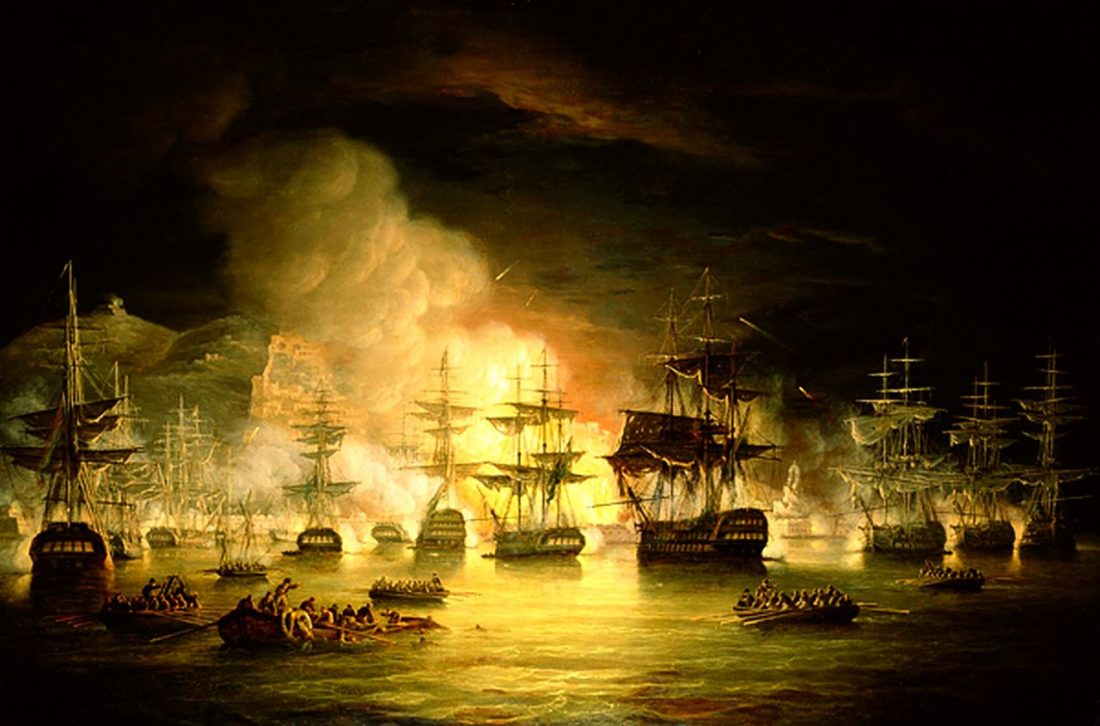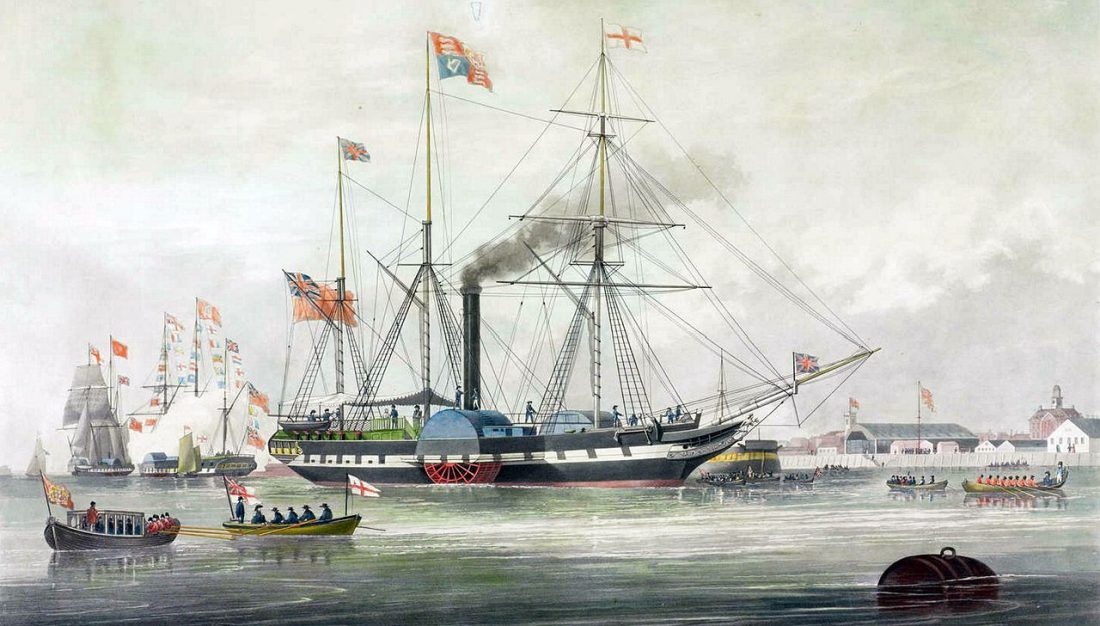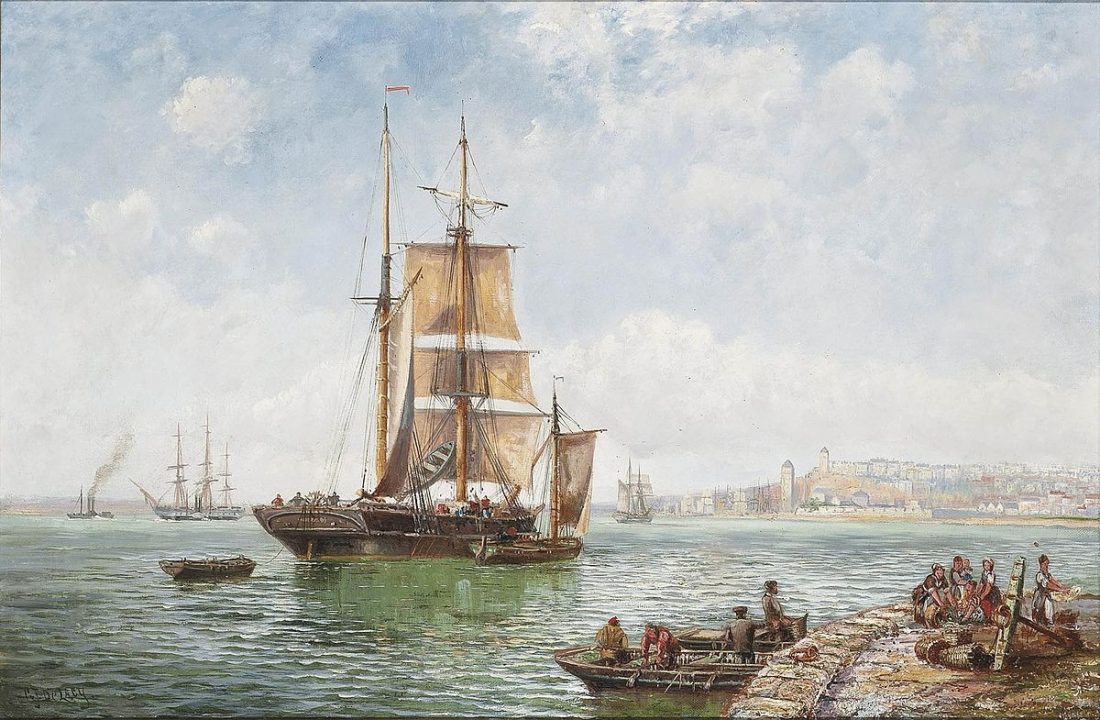Fighting the Riff Pirates 1848-51
The Barbary pirates of North Africa were a scourge to maritime trade for many centuries. It was only in the nineteenth century that major naval and military campaigns – most notably the US Navy’s and Marine Corps’ intervention on “the Shores of Tripoli”, the Anglo-Dutch action against Algiers in 1816 and the French conquest of Algeria in the 1830s – largely put an end to the menace. The qualification “largely” is however important as piracy did continue, albeit on a more spasmodic basis and limited scale than previously.

Anglo-Dutch attack on Algiers, 1816, commanded by Lord Exmouth (Edward Pellew), by Thomas Luny (1759-1837)
Morocco was still independent through most of the nineteenth century and pirates still operated off its Northern Atlantic and Mediterranean coasts – known as the Riff area – in much the same way that Somali pirates have done in our own time. The proximity to important shipping routes passing through the confines of the Straits of Gibraltar or down the African coast ensured potentially rich pickings. Two examples, from as late as 1848 and 1851, and involving the Royal Navy, illustrate the risks to small merchant ships operating in the area. These will be detailed later in this article.
In both these cases, action was undertaken by paddle sloops, a new type of ship, of which 49 were built for the Royal Navy between 1830 and 1851. Though made up of individual classes, these vessels were generally similar as regards tonnage and length – typically less than 1000-tons and of approximately 180-feet long. They carried both sail and steam, the latter power in the form of a reciprocating engine of around 400-horsepower and driving paddlewheels.

Paddle sloop HMS Trident carrying Queen Victoria on a visit to Woolwich Dockyard in 1842. Note size and vulnerability of paddlewheels. (Drawing by William John Huggins)
Though not intended for ship-to-ship combat, since their paddlewheels provided large and vulnerable targets, they carried a powerful armament for their size, typically four 32-pounder or 8-inch smoothbores. With this gun power, and with a crew of 130, of whom a major proportion could be sent ashore as “bluejackets” to constitute small naval brigades, they were ideally suited for action against shore targets or poorly armed adversaries. They saw an amazing range of action – one was to be the first steamer to circumnavigate the globe while others saw action in the Black Sea, North Pacific, Baltic against the Russians in the Crimean War and against the Chinese in the Arrow War whileothers still did valuable survey duty. This surveying, which produced maritime charts, which in updated form, are still in use today, was one of the greatest – and often forgotten and underestimated – achievements of the nineteenth-century Royal Navy.

“A trading brig drifting into a Continental harbour” by Charles John De Lacy (1856-1929) – the unfortunate Three Sisters mighthave looked generally similar.
In 1848 a British trading brig, the Three Sisters, was seized by pirates off the Riff coast. Her master and crew managed to escape but the vessel herself was towed close in to the shore. The duty of retaking her was entrusted to a Commander McCleverty, captain of the paddle sloop HMS Polyphemus. On moving in, he found a force of 500 pirates and tribesmen drawn up on the shore to defend their prize. As Polyphemus neared she was subjected to a hail of musketry. She responded with grapeshot and canister – the ideal method of attack on masses of men – and drove them back. Boats were now sent in under the command of a Lieutenant Allen Gardner to board the Three Sisters and take her out to sea. The pirates and their confederates had now regrouped and opened fire from the cover of rocks, wounding an officer and seven seamen as the oar-propelled boats towed the brig to the Polyphemus. It was a classic example of a small but effective anti-piracy action
Three years later, in 1851, a more serious act of piracy resulted in several deaths and the enslavement of the remainder of the crews, when the brigantine Violet and the schooner Amelia were captured off the Riff coast. When news of this was received at Gibraltar, another paddle slop, HMS Janus, commanded by a Captain Powell, was sent to retaliate. Both of the hijacked vessels were found wrecked on shore but Janus destroyed a number of pirate craft in the vicinity with gunfire. Others were drawn up on the shore and boats were sent in to destroy them. Large numbers of pirates and tribesmen had gathered however and they launched an attack so furious that the landing party had to retreat to Janus, with Captain Powell himself and some of his crew being wounded. The only bright spot was the liberation of the Violet’s crew. It would be interesting – and probably horrifying – to know what became of their counterparts from the Amelia.
These cases were typical of dozens of small and often bloody actions undertaken by the Royal Navy in this period. Forgotten today, they demanded initiative, courage and supreme professionalism, creating in the process a cadre of officers and seamen second to none.
And the paddle sloops? Their day was done by 1860, by which time the screw propeller, with the advantage of being hidden below the waterline, and thus less vulnerable to gunfire, reigned supreme. In their time they had rendered valuable service and they deserve to be remembered with respect.
The latest Dawlish Chronicles novel: Britannia’s Rule
 1886: Captain Nicholas Dawlish, commanding a flotilla of the Royal Navy’s latest warships, is at Trinidad when news arrives of a volcanic eruption on a West Indian island. The situation is worsening and only decisive action can avert massive loss of life. He races there with his ships to render help. His enemy will be an angry mountain, vast in its malevolent power, a challenge that no naval officer has faced before.
1886: Captain Nicholas Dawlish, commanding a flotilla of the Royal Navy’s latest warships, is at Trinidad when news arrives of a volcanic eruption on a West Indian island. The situation is worsening and only decisive action can avert massive loss of life. He races there with his ships to render help. His enemy will be an angry mountain, vast in its malevolent power, a challenge that no naval officer has faced before.
But Dawlish’s contest with the volcano is just the prelude to a longer association with the island. Its sovereignty is split – a British Crown Colony in the west, and in the east an independent republic established seven decades earlier by self-emancipated slaves. When wrenched from France through war, both seemed glittering economic prizes. Now they are impoverished backwaters where resentment seethes and old grudges fester. For many, the existence of a ‘black republic’ is resented, an affront to be excised. In France, a man of limitless ambition, backed by powerful interests, sees the turmoil as an opportunity that could bring him to absolute power. And, if he succeeds, perhaps trigger war in Europe on a scale unseen since the fall of Napoleon.
Through this maelstrom, Nicholas Dawlish must navigate a skillful course. Political concerns complicate challenges that can only be resolved by ruthless guile and calculated use of force. Lacking direct support from the Royal Navy, Dawlish must fight some of the most vicious battles of his career with inadequate resources and unlikely – and unreliable – allies.
Britannia’s Rule can be read as a stand-alone novel, or as part of the Dawlish Chronicles series.
Available in Paperback and Kindle (also readable on smartphones and tablets via Kindle App).
Kindle Unlimited Subscribers can read it, or any of ten other Dawlish Chronicles, at no extra cost.
For more details and for ordering, click below:
For amazon.com For amazon.co.uk For amazon.com.au For amazon.ca
The Dawlish Chronicles – now up to eleven volumes, and with more still to come!
Click on the image below for details of the individual books
Six free short-stories are available for download to your Kindle or Smartphone. Access them by registering for the Dawlish Chronicles mailing list – just click on the banner below. It will update you on new books and provide other free stories at intervals.


